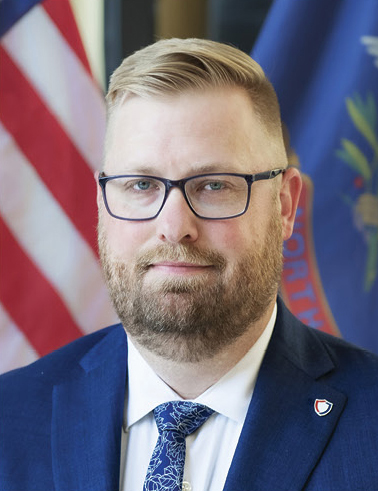
By Preeti Vasishtha
NAIC President Jon Godfread, Nebraska Insurance Commissioner Eric Dunning, Wisconsin Insurance Commissioner Nathan Houdek, and NAIC President-Elect Scott White discuss key regulatory priorities, emerging risks, and the evolving insurance landscape-mapping a path forward through innovation, consumer protection, and risk management.
Editor’s Note: This is the first installment of a two-part interview. Be sure to read the concluding piece in the September/October issue of Contingencies, which highlights the vital connection between the National Association of Insurance Commissioners (NAIC) and the Academy, and the critical role actuaries play in insurance regulation.
Amid rising catastrophe risks, rapid technological change, and ongoing economic uncertainty, insurance regulators are facing complex challenges that demand forward-thinking solutions. From strengthening consumer protections, to enhancing interstate collaboration, to leveraging data-driven oversight, regulators are working to ensure a resilient and responsive insurance system.
In the first installment of a wide-ranging, two-part interview, Jon Godfread, National Association of Insurance Commissioners (NAIC) president and North Dakota’s insurance commissioner; Eric Dunning, Nebraska Department of Insurance commissioner; Nathan Houdek, Wisconsin insurance commissioner; and Scott White, NAIC president-elect and Virginia State Corporation Commission’s Bureau of Insurance commissioner, share how they are charting the future of insurance in an evolving landscape.
What are your top priorities for the year? And when you think about the current state of the U.S. insurance industry-what excites you most, and what keeps you up at night?
Godfread: Throughout this year, our top priorities have centered on maintaining strong, consumer-focused insurance markets while ensuring the regulatory system keeps pace with industry changes. We are focused on strengthening financial oversight, enhancing consumer education, and addressing emerging risks, including those related to artificial intelligence (AI), catastrophe risks, and the evolving health insurance landscape. At the same time, we remain committed to reinforcing the value of the state-based regulatory system both domestically and globally.
What excites me most is the opportunity to modernize and improve the way we regulate insurance in ways that have a tangible impact. Advancements in technology, data analytics, and financial literacy efforts allow us to better protect consumers and ensure that markets remain competitive and fair. The ability to work collaboratively with regulators across the country, industry leaders, and consumer advocates to navigate these changes is both rewarding and essential.
On the other hand, what keeps me up at night are the increasing challenges posed by economic uncertainty, rising catastrophe risks, and the need to ensure that insurance remains accessible and affordable. As the market evolves, so do the risks consumers face, and it’s our job as regulators to anticipate those challenges and adapt. The insurance industry is built on trust-policyholders need to know their coverage will be there when they need it most. That responsibility is what drives our work every day.
Dunning: My top priority for the next two years is helping Nebraska’s personal lines market navigate a challenging market cycle. As we’ve seen a rough combination of inflation and weather-related claims yield increased insurance rates, Nebraska’s policyholders are really struggling and so are the carriers. This is my top priority, and what keeps me up at night. In terms of exciting developments, I’d say that the potential innovation the market has seen over the last few years in the insurtech space has real opportunities to improve people’s lives.
Houdek: At the state level, Wisconsin has a long history of having a stable and competitive insurance market, and our agency is committed to maintaining and supporting that stability and competition to ensure that everyone in our state can benefit from access to affordable coverage options across all lines of insurance. We will continue to promote our Stronger Wisconsin initiative to raise awareness about the importance of building, insuring, and financing more resilient homes and businesses. And we will work with our governor, the legislature, and industry stakeholders to continue building support for initiatives to better inform home and business owners about weather-related risks and incentivize pre-mitigation investments.
At the national level, I look forward to continuing to advance our efforts related to enhanced insurer financial oversight and transparency. I have had the privilege of serving as chair of the NAIC Financial Condition (E) Committee for the past two years, and to serve as co-chair of the Risk-Based Capital Model Governance (EX) Task Force this year. There are several important initiatives taking place under both the E committee and the RBC task force to enhance the tools that regulators have in their toolbox. Successful completion of these initiatives is critical to ensure that regulators can effectively monitor and respond to the shifting insurer investment and reinsurance landscape that we have seen in recent years.
White: I’ve spent most of my career as a state regulator. I’ve been in this space for decades, watching both the insurance industry and state regulation evolve. Often, significant change happens in response to major events or crises-like the Affordable Care Act (ACA) in 2013-14, or before that, the Great Financial Crisis. Those moments drove major shifts in how we operate and regulate.
But when I look at where we are today-the sheer scope and complexity of the issues-we’re facing a unique series of challenges that we haven’t faced before. So the question I ask is: Are we, as state regulators-both in my department and at the NAIC-equipped to handle the rapid changes and potential disruptions?
We’re not just focused on specific issues, but also on whether we have the right foundations in place. With a new CEO at the NAIC, we’re reorganizing to strengthen the organization. We’re building out governance structures and applying project management disciplines across the board to improve how we respond to challenges.
At the state level, we’re also dealing with shrinking budgets and a wave of retirements. That presents a different kind of challenge-ensuring we have the staffing and institutional knowledge to keep pace. We’re actively working on strategies to address that.
Now, when it comes to specific issues, I think if you ask other commissioners, you’ll hear a lot of the same themes. For me, it starts with strengthening our supervisory response to climate risk and natural catastrophes. We’re also focused on adapting to rapid digital innovation and the growing threat of cyber risk.
And more broadly, I think about insurance in its societal role-helping build resilience and close protection gaps. That was a theme former NAIC President Mais emphasized in 2024, and I fully agree. It’s something we have to stay focused on.
So what keeps me up at night? These widening gaps in property insurance due to climate risk, in health insurance, in cyber coverage, and in retirement security. They raise a fundamental question: Is the state-based system up to the task, especially if we’re seeing rising levels of underinsurance and ongoing affordability and availability issues?
I believe the answer is yes, but it’s a serious challenge that requires a proactive and sustained response.
At the state level, we’ve traditionally been very reactive to issues. I’m working to shift that culture-to step back and build in more resiliency. We’ve just created a new department focused on strategy, development, data analysis, and cybersecurity risk. We have the tools and the subject matter experts to take this on, but it takes time, deliberate effort, and the discipline to not just react to the next issue in front of us. That’s the work ahead.
The Role of the NAIC
The National Association of Insurance Commissioners (NAIC) provides expertise, data, and analysis for insurance commissioners to effectively regulate the industry and protect consumers. Founded in 1871, the U.S. standard-setting organization is governed by the chief insurance regulators from the 50 states, the District of Columbia, and five U.S. territories to coordinate regulation of multistate insurers.
How is the broader national landscape shaping your approach and strategic decisions? In what ways would you say the national landscape is impacting the state regulatory environment?
Godfread: The national landscape is evolving rapidly, and that has a direct impact on state regulation. Issues like economic uncertainty, rising costs, and technological advancements-especially in AI and data analytics-are shaping how we approach oversight. Regulators must adapt to these changes while ensuring that markets remain stable and consumers are protected.
At the state level, we’re seeing increased collaboration to address shared challenges. Whether it’s tackling climate-related risks, improving insurance affordability, or monitoring industry consolidation, states are collaborating more closely than ever. Federal discussions on insurance regulation also play a role, and state regulators must remain engaged to ensure that local needs and perspectives are considered.
Ultimately, our focus remains on maintaining strong, consumer-focused oversight while embracing innovation. By staying ahead of national trends and fostering open communication between regulators, industry, and policymakers, we can build a regulatory framework that is both forward-thinking and responsive to today’s challenges.
Dunning: The national landscape and the international landscape are both important factors in decision making. International sources of capital are an important part of helping Americans manage risk. Making sure we understand decisions and resources made in that context will be increasingly important over time. As insurance remains primarily focused on state solutions for regulation, that national landscape takes a bit of a back seat. So, it’s an interesting mix. We need to focus on national landscapes certainly, but not lose sight of the primacy of the states in the space.
Houdek: The issues impacting Wisconsin’s insurance market-severe weather events, economic uncertainty, supply chain disruptions-are the same issues affecting states across the country. Insurance regulation is a state-based system, but with greater consolidation and an increasing number of multi-state carriers, a national approach to regulation is critical. Wisconsin is active with the NAIC to ensure regulatory consistency and certainty, work collaboratively to respond to emerging risks and challenges, and share best practices and lessons learned to effectively protect consumers.
White: I tend to think about this in two buckets. First is the broader political environment and how it interacts with our state-based regulatory system, particularly in relation to what’s happening in Washington. The second one is the more general impact of working in a highly polarized political climate, and how that affects us at the NAIC.
Under the current administration, we’ve seen less activity in the insurance space compared to the previous administration. In some areas, there’s been a clear pullback; in others, such as health insurance, we’ve noticed a significant reduction in resources and federal engagement. That creates a lot of uncertainty, especially in domains where there’s overlap between federal and state interests in regulating insurance.
Having been in this field for a long time, I’ve seen the pendulum swing between administrations. Republican administrations tend to defer more to the states and emphasize federalism. We view that as an opportunity to strengthen the state-based system so that when federal oversight inevitably increases again, as it did under the Biden administration in areas like climate, we’re well-positioned to respond. For example, the climate executive order issued under the Biden administration spurred significant work over the past few years, and we had to adapt and address its implications.
Right now, we’re in a period where we can reinforce our state-based regulatory structure. At the same time, we recognize the importance of maintaining constructive relationships with the federal government. That includes collaboration with Congress on funding for resilience efforts like home hardening, coordination with FEMA on the National Flood Insurance Program, and close partnership with the U.S. Department of Health and Human Services’ Centers for Medicare & Medicaid Services on ACA markets.
Internationally, I’ve also been involved in what we call “Team USA,” which brings together the U.S. Department of Treasury, Federal Insurance Office, the Federal Reserve, and state regulators to engage with the International Association of Insurance Supervisors (IAIS). We’ve worked together on a multi-year project to implement a U.S.-specific group capital standard-one that differs from international models. This has required coordinated advocacy to explain the unique features of our regulatory system and why our approach works in monitoring systemic risk and adopting best practices globally.
Now, regarding the polarized domestic environment, it’s definitely a challenge, especially on issues like climate risk and resilience. But our approach has been to seek common ground. We ask: Where can most members agree? Where do we have shared priorities?
One success story is our collective focus on resiliency. States across the political spectrum-red and blue-are adopting programs that support home hardening. Alabama pioneered this with its FORTIFIED Home™ program, and states like California have followed suit. That’s a tangible example of bipartisan progress on a pressing issue.
One of the great strengths of the NAIC is that we come together in person and work collaboratively-regardless of our politics or geography. Preserving that culture is essential.
I’ll add that the Academy is a key partner in this process. We rely on its trusted, balanced, and data-driven work as a foundation for informed discussions, especially when tackling tough and complex issues. Its credibility helps create a space where we can engage constructively and move forward. (Read more about the Academy’s work with the NAIC in the second and final part of the interview in the September-October issue of Contingencies.)
Meet the Commissioners

Jon Godfread is the NAIC president and also serves as the chair of the Government Relations (EX) Leadership Council and vice-chair of the Senior Issues (B) Task Force. He has led the North Dakota Department of Insurance as commissioner since 2016.

Eric Dunning chairs the NAIC’s International Insurance Relations (G) Committee and has been Nebraska’s insurance director since 2021.

Nathan Houdek serves as chair of the Financial Condition (E) Committee. He is the co-chair of the new Risk-Based Capital Model Governance (EX) Task Force, as well as the vice chair of the Governance Committee of the Interstate Insurance Product Regulation Commission. Houdek was appointed Wisconsin’s commissioner of insurance in 2022.

Scott White is the NAIC president-elect and serves as the vice-chair of the Life Actuarial (A) Task Force. He has served as commissioner of the Virginia State Corporation Commission’s Bureau of Insurance since 2018.
How are state legislative priorities influencing your regulatory agenda?
Godfread: Having good relationships with our state lawmakers is a crucial component of insurance regulation. Legislators set the framework within which we operate. As regulators, we work to implement and enforce policies that align with those priorities while ensuring the stability and fairness of the insurance marketplace.
One central area of legislative focus is consumer protection. Whether it’s strengthening safeguards against fraud, enhancing transparency in policy offerings, or ensuring fair claims handling, state lawmakers are driving efforts that directly impact how we regulate. While consumers should and are at the forefront of our work, we also need to strike a balance between the benefits and coverage they receive with the premiums they pay, along with the solvency and competitiveness of companies that operate in our respective markets. With that said, educating our legislative partners on the inner workings of insurance is key to developing legislation that benefits as many people as possible.
Dunning: The increasing attention on pharmacy benefit managers at the state level has been a key area of focus for us for several years.
Houdek: Our agency maintains strong relationships with members of our state legislature and works to share our priorities early in the legislative session and state biennial budget process to ensure that elected officials and their staff are well informed as they consider insurance-related proposals. In recent years, we have successfully worked with our state legislature to secure authority and funding for additional positions at our agency, and to pass legislation related to data security, licensure of pharmacy benefit managers, adoption of the best interest standard for annuity sales, and increased forfeitures for insurance law violations against elderly and at-risk individuals.
White: In Virginia, as an independent agency, we have to be very responsive to both consumers and the business community to ensure a healthy insurance market. One of the main ways we hear those signals is through the legislature-whether that’s through bills that are introduced, formal inquiries, or when we appear before legislative committees. Of course, we also get input directly from consumers through complaints and other channels, but legislative activity is a critical source of information on where our focus should be.
When we look at the types of bills and inquiries that come our way, they tend to fall into three broad categories.
First, health insurance. Every year, we might see around 100 insurance-related bills filed in Virginia, and about 80 of those are related to health insurance. That tells us we need to have deep expertise in that area-to be able to answer questions and serve as a trusted, nonpartisan source of guidance to the legislature. We don’t take positions on legislation, but we are there to provide accurate, timely information.
Second, long-term care insurance. Genworth Financial-the largest writer of long-term care insurance in the U.S.-is headquartered in Richmond. On top of that, many Virginia consumers have purchased long-term care policies and have been hit with significant rate increases over the past few years. Understandably, this has caused concern and pushback, and the legislature has responded. We’ve had to do a lot of work to address these concerns and explain the rationale behind rate changes.
Third, there’s growing concern around the affordability and availability of property insurance. While we haven’t yet seen home hardening laws or grant programs in Virginia like those adopted in other states, we want to be prepared. If a legislator introduces a bill or asks about it, we need to be ready with a thoughtful response.
As commissioner, my responsibility is to make sure our department has the expertise to address these issues effectively. And we don’t just stop at the state level-we bring that expertise and on-the-ground experience to the NAIC, contributing to national conversations.
Take long-term care, for example. We’ve been very involved in NAIC discussions over the past five years aimed at addressing inconsistencies in how states approve rate increases. Striking a fair balance has been a heavy lift, especially for actuaries. A small but dedicated team has worked on a methodology that promotes fairness in cost-sharing-essentially asking: how should the burden be shared among consumers, insurers, and the state regulators who must approve these increases?
Health insurance is another area where Virginia has been proactive. There’s been growing interest in alternatives to the ACA for the small group market, such as association health plans and other models promoted by think tanks in D.C. Some of those ideas have made their way into Virginia law, and we’ve had to build new regulatory frameworks around them. We’ve also brought those developments to the NAIC to make other states aware because once these models are introduced in one state, they often start popping up in others. It’s important to share what that legislation looks like and how it might impact markets and regulatory departments elsewhere.
So, those are just a few examples but they show how state-level signals shape our priorities and how we bring that experience to the broader national conversation.

As an insurance commissioner, you navigate both risk management and inherent biases. How do you find the right balance between the two?
Godfread: Striking the right balance starts with a commitment to fairness, transparency, and data-driven decision-making. Insurance regulation exists to protect consumers while ensuring a stable and competitive marketplace. That means we must evaluate risks objectively, relying on sound financial oversight and actuarial principles rather than assumptions or outdated models.
One of the key ways we navigate this balance is through collaboration, engaging with industry leaders, consumer advocates, and fellow regulators to ensure that we consider different perspectives. By prioritizing consumer education, fostering open dialogue, and continuously refining our regulatory approach, we can address biases, mitigate risks, and maintain trust in the system.
At the same time, we recognize that risk itself is evolving. Whether it’s the impact of natural disasters on insurance, the rise of artificial intelligence in underwriting, or the rise in health care costs, we must stay ahead of these changes while ensuring that innovation benefits policyholders. The goal is always to create a system that is both resilient and responsive, one that protects consumers without stifling progress or competition. That balance is not always easy, but it’s what makes state-based regulation so effective; it allows us to be flexible, proactive, and deeply connected to the communities we serve.
Dunning: Carefully.
Houdek: As insurance commissioner, my priorities are protecting consumers, monitoring insurer solvency, and ensuring compliance with Wisconsin’s insurance laws and regulations. State statute prohibits unfair discrimination in rate-setting, claims processing, and other insurance business practices. We also ensure that rates are appropriately risk-based and adequate to prevent insolvency, so consumers aren’t negatively impacted by an insurer with insufficient capital to pay claims. Effective consumer protection is about balancing both elements-regulation of market business practices and solvency oversight. Consumer education is another important component because well-educated and informed insurance consumers better understand their own risks and protection needs.
White: There’s an ongoing tension we have to manage. On one hand, we want insurance companies to be financially stable and able to pay claims. That means we need accurate risk assessment, which often involves risk-based pricing. But on the other hand, we also need to ensure that these practices don’t result in unfair discrimination.
As companies get more sophisticated in how they price products-and, all things being equal, that’s generally a good thing-they’re increasingly relying on data-driven methods. However, some of those methods raise concerns around algorithmic bias or unfair proxy discrimination. That’s where we, as regulators, have to step in and make sure their practices align with our laws and consumer protections.
This debate really came into sharper focus following the murder of George Floyd. In response, we formed a Special Committee on Race and Insurance to look at potential inequities in insurance practices. Around the same time, we also formed a committee focused on developing a regulatory framework for the use of AI in insurance.
You can really see the intersection of these two efforts. We’re dealing with traditional actuarial methods that might appear objective on the surface, but we’ve come to understand they can sometimes perpetuate-or even amplify-existing societal inequities. So we had to take a closer look at risk-based pricing, proxy discrimination, and the growing use of predictive rate models.
How do we address that? One approach is making sure companies follow inclusive data governance frameworks. That’s something we emphasized in an AI bulletin (Use of Artificial Intelligence Systems by Insurers) the NAIC adopted last year. It’s critical to involve a diverse group of stakeholders in these conversations.
We’re especially focused on asking companies the right questions: What data are you collecting? How are you documenting and reporting it? What process are you using to validate your models? And what bias mitigation strategies are in place? As regulators, we don’t claim to be the technical experts-but we do need to ensure the companies went through a rigorous process and that there aren’t concerns around proxy discrimination.
And this is where the actuarial community has been incredibly helpful. At the NAIC, there’s a dedicated department that reviews predictive rate filings submitted by the states. We also work with consulting actuaries when questions arise, and they help us evaluate those filings and navigate any concerns we have.

How are climate-related events impacting insurance policies, and what challenges do they pose for regulators?
Godfread: Climate-related events, such as wildfires, hurricanes, and floods, are having a significant impact on insurance policies, particularly in terms of affordability, availability, and risk assessment. These events are becoming more frequent and severe, which not only increases the cost of claims but also makes it more challenging for insurers to accurately assess and price risk. As a result, policyholders in high-risk areas may face rising premiums, reduced coverage options, or even the inability to obtain coverage at all.
For regulators, the challenge lies in striking a balance between the need for insurers to remain financially viable and ensuring that consumers have access to affordable and reliable coverage. We must be proactive in assessing the growing risks posed by climate change, which means continually adjusting regulatory frameworks to account for new data, emerging risks, and industry innovations. One of the major challenges is addressing the potential for market disruptions, such as insurers withdrawing from high-risk areas, which can leave consumers without viable options.
At the same time, regulators must ensure that insurers take appropriate steps to manage their exposure to these risks. This might involve enhancing risk-based capital requirements or developing new guidelines for underwriting practices that reflect the evolving landscape.
Another key priority is advancing consumer education so individuals understand the risks they face and know how to mitigate those risks through preparedness, insurance options, and resilience measures.
Ultimately, climate-related events pose a persistent challenge for regulators, but they also present an opportunity to enhance the regulatory system. By fostering collaboration among insurers, government agencies, and communities, we can work toward creating a more resilient insurance market that can better withstand the impacts of climate change while continuing to protect consumers.
Dunning: Our homeowners market is seeing significant claims, leading to significant premium increases. A run of severe weather events in the state, along with inflation, has contributed to this trend. It remains to be seen how the market will respond.
Houdek: The increasing prevalence and severity of climate disasters presents a serious risk to the economic stability of property owners, small businesses, and entire communities. Wisconsin is facing an increasing risk of flooding, hail, high winds, and other devastating weather events. Insurers are adjusting their premiums and policies to account for these risks which is putting increased price pressure on consumers. Our role as regulators is to ensure the solvency of insurers, educate consumers about their climate risks, and work collaboratively with stakeholders to develop solutions for mitigation that will lessen the impact of more frequent and severe weather events.
White: This is the big issue that all states are dealing with right now. It’s a top priority at the NAIC-addressing affordability and availability challenges in the property insurance market. These challenges are partly, but not exclusively, driven by natural catastrophes and climate risk.
On the availability side, we’re seeing some insurers respond by writing fewer policies or exiting certain markets altogether. But from a regulatory standpoint, our focus is primarily on affordability: the cost of insurance, underwriting practices, and product design because that’s where we have more direct authority.
When it comes to product design, we’re seeing some positive developments. Mitigation efforts are increasingly being rewarded through discounts. For example, in Colorado, if a homeowner takes steps to protect the perimeter of their property against wildfires, they may qualify for a premium discount. The same goes for fortified roofs in Alabama-installing one could make you eligible for a lower rate.
At the same time, we’re also seeing insurers shift more risk onto consumers through higher deductibles and other cost-sharing mechanisms. From a technical standpoint, things are becoming more complex. There’s greater use of catastrophe modeling in underwriting. So, if a company offers a discount based on a model, say for wildfire mitigation, we have to ensure that discount is actuarially justified. That means regulators now need to review and understand those models, which wasn’t something we were doing even five years ago. It’s an area we have to stay on top of and continue adapting to.
Another issue that comes up often in our department is whether catastrophes in one region affect premiums in another. For instance, after the California wildfires, we’d get questions from Virginia policyholders asking, “Is my insurance company going to raise my rates because of what happened in California or Florida?” The underlying concern is cross-state subsidization.
There was a paper by a Harvard professor that gained a lot of attention, even being cited by the Senate Banking Committee, arguing that such subsidization might be happening. I asked our actuary to review it closely-to look at the assumptions and determine whether the concerns were valid. Our view is that, in a competitive market like Virginia, this kind of subsidization shouldn’t occur. But we wanted to test that assumption.
We elevated the issue to the NAIC and brought together a group of actuaries from across the country to analyze the paper. We wanted to understand whether any of the arguments held water-and if not, we needed clear, analytical reasoning to back our position. That’s where actuarial analysis is incredibly valuable. It helps us refine our understanding and make stronger, evidence-based decisions.
And finally, I’ll say that understanding our markets at a granular level is more important than ever. Last year, we participated in the largest data call in our history, collecting information down to the zip code level. Now, in Virginia, we don’t just know what’s happening at the state level-we can see patterns at the county level too.
For example, we can now identify if, say, in the Chesapeake Bay region, an insurer is shifting more cost onto consumers, or if there’s a growing concentration of risk in a particular area. Thanks to these tools and the data we now have access to, we’re gaining insights into our market that allow us to respond much more effectively.

Where do you see opportunities to better educate and support consumers, employers, and other policymakers on insurance and financial risk?
Godfread: There are numerous opportunities to better educate consumers, employers, and policymakers about insurance and financial risk; it’s simply a matter of making the information accessible, relevant, and easy to understand. Insurance can be complicated, and most people don’t think about their policies until they’re needed. That’s why proactive education is so important.
For consumers, the goal is to help them make informed decisions before a crisis happens. This means enhancing outreach on key topics, such as disaster preparedness, the importance of adequate coverage, and navigating claims when the unexpected occurs. Whether through digital resources, community events, or direct engagement, we must meet people where they are and provide them with clear, actionable information.
And when it comes to policymakers, education is crucial in ensuring they have a comprehensive understanding of how insurance regulation works and its significance. Whether we’re discussing emerging risks such as AI, catastrophe challenges, or market stability, lawmakers require reliable information to make informed decisions. Open communication, real-world examples, and data-driven insights enable us to collaborate on shaping policies that benefit both consumers and the industry.
Ultimately, insurance is about trust. The more we can do to educate and empower people, the stronger and more resilient our system will be.
Dunning: The best way for me to stop a conversation with a stranger is to tell them that I work in insurance. There’s an incredible lack of engagement on insurance-related issues that I find really challenging. Risk transfer is a significant part of people’s monthly budget, but the amount of attention and thought given to that part of household spending is really minimal, especially when you factor in what’s at stake. Nebraska’s got a really talented public information person, who is working to improve our public communication. We have a great Senior Health Insurance Program that works hard to get seniors the information they need to make good Medicare-related decisions. Our health insurance team travels across our very large state to help hospital personnel and policyholders understand the health insurance market. I’ll talk your ear off about insurance, and lately, the need for better roofing materials. But even with those efforts, it’s a real struggle.
Houdek: Our agency’s mission is to protect and educate Wisconsin insurance consumers, and that core responsibility has not changed since our agency was created in 1870. To fulfill our mission, we regularly communicate with consumers and other stakeholders through direct meetings, informational documents, social media, and educational forums. We know that insurance can be difficult to understand so we are constantly working to keep consumers, policymakers, and the general public informed and serve as an informational resource. We also co-chair the governor’s Task Force on Financial Literacy and Capability which is focused on building financial and insurance understanding and identifying ways to improve the financial inclusion for all Wisconsin residents. There is always more to do when it comes to educating individuals about financial and insurance literacy and improving understanding of risk management, and we continue to partner with other regulators, state agencies, nonprofit organizations, the industry, and other concerned stakeholders to advance those efforts.
White: It’s something we think a lot about, both in Virginia and nationally. In today’s media environment, how do you get people to pay attention to something like insurance, which they’re not naturally drawn to? And how do you communicate such a complex topic in a way that resonates with them?
We focus on meeting people where they are-that’s one approach we use. Let me give you two examples where this plays out.
First, we created a state-based insurance exchange in Virginia. Unlike the federal government’s marketplace, we opted to run our own. One of the reasons for this decision was that we believed we could provide more resources to reach people who aren’t currently insured and help them get the information they need to enroll. The ACA provides subsidies based on your income relative to the federal poverty level, so there’s really no reason why our uninsured rate should be as high as 8%-10%. It’s about reaching those people, explaining that they could get low-cost or even no-cost coverage, and helping them understand why it’s important. We’ve seen impressive strategies from our marketplace team to get people to sign up, and a big part of that has been developing a communication strategy that’s data-driven and targeted to where people are. It’s been a learning experience for us.
The second example is flood insurance. The uptake rate for flood insurance, particularly among low-income residents, is alarmingly low-only around 7%-10% in Virginia. More people should have coverage. A good example is the people in Asheville, North Carolina, who didn’t realize they needed flood insurance until the hurricanes hit last fall. This is where better outreach becomes a cornerstone of our climate risk strategy. It’s also about educating people on home marketing discounts and the incentives available to protect their homes and drive down claims.
This applies to other areas as well-people who need life insurance but don’t currently have it. The big question is: How do we persuade them? I look at past campaigns, like those against smoking or drunk driving, which have been remarkably successful. What techniques did they use, and could we adapt those strategies to increase uptake rates for flood insurance, home hardening, health insurance, or life insurance?
I’ve reached out to the NAIC Center for Insurance Policy and Research to ask them to do some research on these campaigns. I want them to compare those past strategies with what we’re doing now and suggest improvements. I’m really excited about the insights we might gain from that research and how we can apply them in the coming years.
Preeti Vasishtha is Editor-in-Chief, Contingencies, and the Academy’s Director of Content.